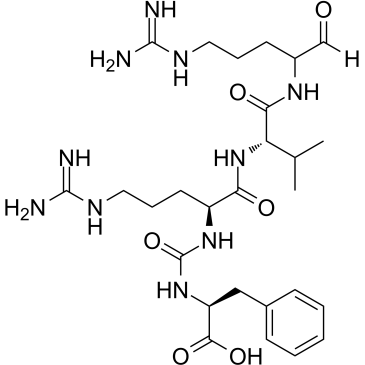抗痛素

抗痛素结构式

|
常用名 | 抗痛素 | 英文名 | Antipain |
|---|---|---|---|---|
| CAS号 | 37691-11-5 | 分子量 | 604.70200 | |
| 密度 | 1.38 g/cm3 | 沸点 | N/A | |
| 分子式 | C27H44N10O6 | 熔点 | N/A | |
| MSDS | 中文版 美版 | 闪点 | N/A | |
| 符号 |

GHS07 |
信号词 | Warning |
抗痛素用途Antipain 是一种从 Actinomycetes 分离的蛋白酶 (protease) 抑制剂。Antipain 抑制 N-甲基-N'-硝基-N-亚硝基胍 (MNNG) 诱导的转化,增加染色体畸变。 |
| 中文名 | 抗痛素 |
|---|---|
| 英文名 | antipain hydrochloride dihydrate |
| 中文别名 | 抗蛋白酶,2HCl | 抗蛋白酶 |
| 英文别名 | 更多 |
| 描述 | Antipain 是一种从 Actinomycetes 分离的蛋白酶 (protease) 抑制剂。Antipain 抑制 N-甲基-N'-硝基-N-亚硝基胍 (MNNG) 诱导的转化,增加染色体畸变。 |
|---|---|
| 相关类别 | |
| 参考文献 |
| 密度 | 1.38 g/cm3 |
|---|---|
| 分子式 | C27H44N10O6 |
| 分子量 | 604.70200 |
| 精确质量 | 604.34500 |
| PSA | 277.50000 |
| LogP | 2.64660 |
| 折射率 | 1.631 |
| 储存条件 | −20°C |
| 计算化学 | 1、 疏水参数计算参考值(XlogP):-2.7 2、 氢键供体数量:9 3、 氢键受体数量:12 4、 可旋转化学键数量:19 5、 拓扑分子极性表面积(TPSA):283 6、 重原子数量:43 7、 表面电荷:0 8、 复杂度:975 9、 同位素原子数量:0 10、 确定原子立构中心数量:4 11、 不确定原子立构中心数量:0 12、 确定化学键立构中心数量:0 13、 不确定化学键立构中心数量:0 14、 共价键单元数量:1 |
|
A kinetic characterization of the gill V(H(+))-ATPase in juvenile and adult Macrobrachium amazonicum, a diadromous palaemonid shrimp.
Comp. Biochem. Physiol. B Biochem. Mol. Biol. 181 , 15-25, (2015) Novel kinetic properties of a microsomal gill V(H(+))-ATPase from juvenile and adult Amazon River shrimp, Macrobrachium amazonicum, are described. While protein expression patterns are markedly differ... |
|
|
Inhibition of cathepsin proteases attenuates migration and sensitizes aggressive N-Myc amplified human neuroblastoma cells to doxorubicin.
Oncotarget 6 , 11175-90, (2015) Neuroblastoma arises from the sympathetic nervous system and accounts for 15% of childhood cancer mortality. Amplification of the oncogene N-Myc is reported to occur in more than 20% of patients. Whil... |
|
|
Lysosomal membrane permeabilization: carbon nanohorn-induced reactive oxygen species generation and toxicity by this neglected mechanism.
Toxicol. Appl. Pharmacol. 280(1) , 117-26, (2014) Understanding the molecular mechanisms responsible for the cytotoxic effects of carbon nanomaterials is important for their future biomedical applications. Carbon nanotubular materials induce the gene... |
| MFCD00135959 |
| Phe-co-Arg-Val-L-Arg-h |
| N2-[[(1-carboxyphenethyl)amino]carbonyl]-L-arginyl-N-[4-[(aminoiminomethyl)amino]-1-formylbutyl]-L-valinamide |
| EINECS 253-631-0 |
| 4-((aminoiminomethyl)amino)-1-formylbutyl) |
| N2-[[(1-Carboxy-2-phenylethyl)amino]carbonyl]-L-arginyl-N-[4-[(aminoiminomethyl)amino]-1-formylbutyl]-L-valinamide |


